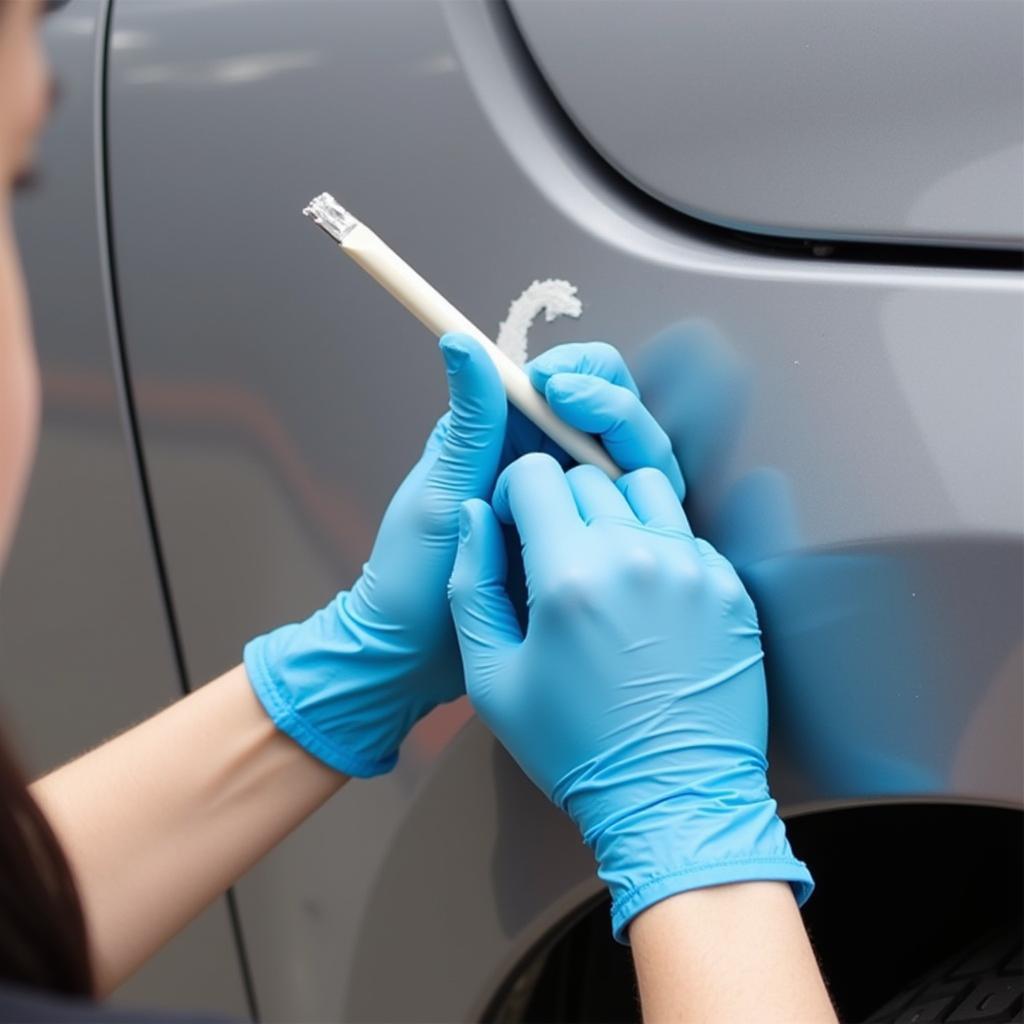Discovering paint chips on your car can be disheartening, but fear not! This comprehensive guide will equip you with the knowledge and techniques to tackle those pesky blemishes like a pro. Whether you’re a DIY enthusiast or seeking information before consulting a professional, we’ve got you covered.
Understanding Paint Chips: Why They Appear and Why You Should Address Them
Paint chips occur when something impacts your car’s surface with enough force to chip away the paint. Common culprits include road debris, stones, gravel, and even minor collisions. Ignoring these seemingly small imperfections can lead to bigger problems down the road:
- Rust Formation: Exposed metal underneath the chipped paint is vulnerable to rust and corrosion, especially in humid or wet climates.
- Decreased Resale Value: A car with noticeable paint chips appears poorly maintained, significantly impacting its resale value.
- Aesthetic Drawback: Paint chips detract from your car’s overall appearance, making it look older and less appealing.
Assessing the Damage: Is It a DIY Job?
Before rolling up your sleeves, assess the severity of the paint chips.
- Minor Chips: Small, shallow chips that haven’t penetrated the primer layer can often be fixed with touch-up paint.
- Medium Chips: Chips that expose the primer or a small amount of metal might require a multi-step process involving sanding, priming, and painting.
- Large Chips: Extensive damage, deep scratches, or areas with significant rust require professional attention for optimal results.
For minor and some medium chips, DIY fixes are achievable and cost-effective. However, fixing large paint chips car often demands the expertise and tools of a professional body shop.
DIY Paint Chip Repair: Tools and Techniques
Fixing minor to moderate paint chips can be a satisfying DIY project. Here’s what you’ll need:
Tools:
- Car wash soap and water
- Microfiber towels
- Rubbing alcohol
- Automotive touch-up paint (matching your car’s color code)
- Clear coat
- Fine-grit sandpaper (2000-grit or higher)
- Polishing compound
- Wax
Step-by-Step Guide:
-
Clean the Area: Wash your car thoroughly, paying special attention to the chipped area. Use rubbing alcohol to remove any remaining dirt or wax.
-
Apply Touch-Up Paint: Shake the touch-up paint well. Using the applicator brush provided, carefully dab a small amount of paint onto the chip, ensuring it fills the entire cavity. It’s better to apply multiple thin coats, allowing each coat to dry completely, than one thick coat.
-
Apply Clear Coat: Once the touch-up paint is dry (refer to the manufacturer’s instructions for drying time), apply a thin layer of clear coat to protect the area and blend it with the surrounding paint.
-
Sand and Polish (Optional): If there’s any excess paint or unevenness after the clear coat dries, use fine-grit sandpaper to gently smooth the area. Follow up with polishing compound and wax for a seamless finish.
 Applying touch-up paint to a car chip
Applying touch-up paint to a car chip
Preventing Future Paint Chips: Protective Measures
Prevention is always better than cure. Safeguard your car’s paint with these proactive measures:
- Regular Washing: Wash your car regularly to remove dirt, grime, and corrosive substances.
- Waxing: A coat of wax acts as a protective barrier against minor scratches and UV damage.
- Parking Strategically: Park your car away from areas prone to flying debris, such as construction zones.
- Paint Protection Film: Consider investing in a paint protection film (PPF), a transparent urethane film that shields your car from chips, scratches, and environmental damage.
When to Call the Pros
While DIY repairs work well for minor chips, some situations warrant professional help.
- Large or Deep Chips: Extensive damage requires specialized tools, techniques, and color-matching expertise to achieve a seamless repair.
- Rust Formation: Rust needs to be completely removed before any repair work can be done. Professionals have the tools and expertise to address rust effectively.
- Lack of Confidence: If you’re not comfortable tackling the repair yourself, don’t hesitate to seek professional help.
Remember, professional repairs may be more expensive upfront but can save you time, effort, and potential headaches down the line.
Frequently Asked Questions About Fixing Paint Chips on Cars
Q: Can I use nail polish to fix a paint chip?
A: While it might seem like a quick fix, nail polish is not formulated for automotive paint and can react negatively, damaging the existing paint.
Q: How long does touch-up paint take to dry?
A: Drying time varies depending on the type of touch-up paint, the number of coats applied, and environmental factors. Always refer to the manufacturer’s instructions for accurate drying times.
Q: Can I fix paint chips in any weather condition?
A: Extreme temperatures and humidity can affect the drying and curing process of touch-up paint. It’s best to work in a well-ventilated area with moderate temperatures.
Q: How do I find the exact paint color code for my car?
A: Your car’s paint code is usually located on a sticker inside the driver’s side door jamb, glove compartment, or under the hood. You can also find it in your owner’s manual.
Q: How do you fix paint chips on your car that are on a plastic bumper?
A: The process for fixing paint chips on plastic bumpers is similar to metal surfaces, but you might need a specialized plastic primer for better adhesion.
Need Expert Assistance?
Addressing paint chips promptly protects your car’s value and appearance. By following the steps outlined in this guide, you can confidently tackle minor to moderate chips yourself.
If you’re dealing with extensive damage or prefer professional expertise, reach out to the trusted team at AutoTipPro. Our experienced technicians are equipped to handle all your car repair and maintenance needs. Contact us at +1 (641) 206-8880 or visit our office at 500 N St Mary’s St, San Antonio, TX 78205, United States.






Leave a Reply